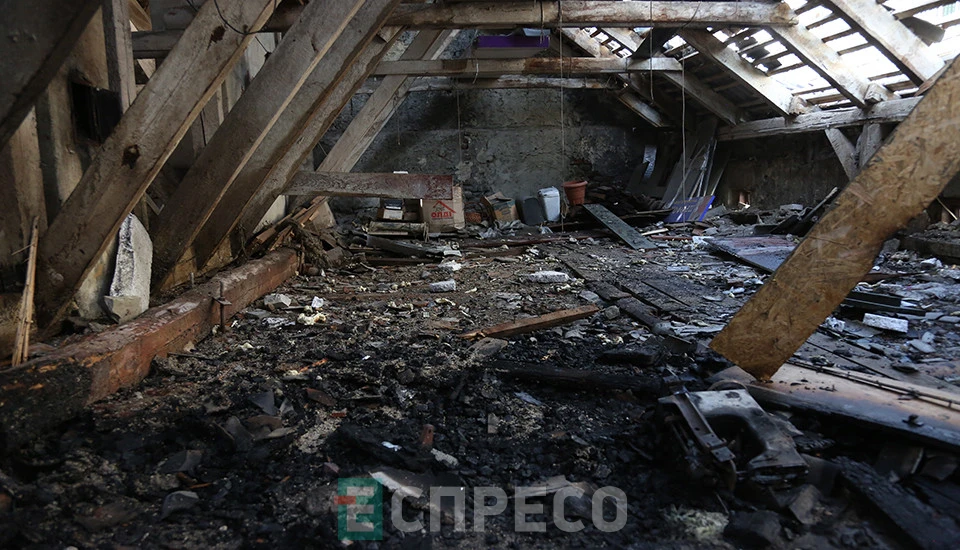Cluster munitions from Russian missile in Lviv pose unpredictable threat — expert
global.espreso.tv
Thu, 21 Aug 2025 17:54:00 +0300

Defense Express CEO Serhiy Zgurets stated this on Espreso TV.As the expert explains, Russian Kh-101 cruise missiles have already undergone several modernizations during their use. In particular, new warheads were created that increased the charge mass to 450 kilograms. And the design of these warheads can be different."If earlier we already recorded strikes on airfields using cluster warheads, now we see their use against civilian cities, particularly in Lviv. The cluster warhead differs from high-explosive in that instead of a solid charge, it contains dozens of submunitions - metal spheres with a diameter of about 15 centimeters. They scatter over a significant area and are primarily designed to destroy aircraft on runways. But now they are being used to hit objects located in civilian cities, particularly in Lviv," notes Serhiy Zgurets.Main danger of cluster munitions for the cityThe main danger is precisely those submunitions that in any case scatter across the territory, but can have different trajectories - depending on whether the missile was shot down or, conversely, hit the target."If we're talking about the scattering of cluster elements, everything depends on the height at which the warhead detonation occurred. If the missile was shot down and detonation did not occur, then these spheres simply scattered along with the debris and could end up in any area. It's difficult to determine this in advance," emphasizes the military expert. "Actually, we don't know the self-destruction mechanism in those spheres: whether they are equipped with this self-destruction mechanism or not, after what time they can self-destruct, or generally remain in an armed combat state for a long time and can explode, for example, when moved." He adds that each such element has its own detonation mechanism: the fuse can be designed to explode in the air, after hitting the ground, or even after a certain time independently. Therefore, pyrotechnicians are now working on site - collecting debris, removing or detonating it. And it is precisely the different designs of these fuses that create the greatest challenges for our specialists."In any case, this is not news. However, we see a trend: instead of ordinary high-explosive warheads, Russia increasingly uses cluster munitions that scatter explosive ball-shaped elements. This significantly increases the danger," notes Serhiy Zgurets.At the same time, the rules of behavior remain the same as in the case of any other explosive objects: don't touch independently, especially under no circumstances move anywhere, and also warn the relevant services."If you don't know what kind of object it is, it resembles an explosive device, regardless of what structure and capabilities are there, then it's necessary to warn our structures, particularly the police, which will promptly direct sappers to this area. And I think this is the only way of the most rational behavior. Don't take in hands, don't move, that is, these are general rules that have already been announced to our citizens many times," he emphasizes.How to protect yourself during shelling: where it's best to hide in case of attacks using cluster munitionsIf there's no possibility to go down to a shelter, then the two-wall rule can also become salvation. After all, we're talking about scattered elements with less power, unlike the case of a large warhead hit."Two walls really save, because the power of an individual explosive element from a cluster warhead is significantly less than that of the entire missile warhead weighing 450 kg. If such a large munition hits a building - the consequences are much more serious. And an individual spherical element has less effect, so safety measures in the format of 'two walls' work," the expert believes.Serhiy Zgurets also notes that their use in Lviv is unlikely to become a very mass phenomenon, since a cruise missile costs much more than a Shahed, so precisely the use of drones is more suitable for the Russians' terror tactics. Instead, the use of cruise missiles is oriented toward strikes on priority targets for the enemy, that is, industrial, military, or even scientific ones if they are related to military affairs."If we talk about strikes on Lviv, particularly on Oleny Stepanivny Street, we see several repeated hits precisely there. Although there are no military objects there - neither to the armed nor unarmed eye. This may indicate that the Russians have some suspicions about industrial capacities in this area and are trying to hit objects they consider industrial or military, based on their own target assessments. For this, they choose a warhead - high-explosive or cluster, as this time. In any case, it looks like the enemy either has incorrect reference points or doesn't receive confirmation of hits. After all, the repeatability of attacks precisely along this line raises many questions," he concludes.Attack on Lviv on August 21
He adds that each such element has its own detonation mechanism: the fuse can be designed to explode in the air, after hitting the ground, or even after a certain time independently. Therefore, pyrotechnicians are now working on site - collecting debris, removing or detonating it. And it is precisely the different designs of these fuses that create the greatest challenges for our specialists."In any case, this is not news. However, we see a trend: instead of ordinary high-explosive warheads, Russia increasingly uses cluster munitions that scatter explosive ball-shaped elements. This significantly increases the danger," notes Serhiy Zgurets.At the same time, the rules of behavior remain the same as in the case of any other explosive objects: don't touch independently, especially under no circumstances move anywhere, and also warn the relevant services."If you don't know what kind of object it is, it resembles an explosive device, regardless of what structure and capabilities are there, then it's necessary to warn our structures, particularly the police, which will promptly direct sappers to this area. And I think this is the only way of the most rational behavior. Don't take in hands, don't move, that is, these are general rules that have already been announced to our citizens many times," he emphasizes.How to protect yourself during shelling: where it's best to hide in case of attacks using cluster munitionsIf there's no possibility to go down to a shelter, then the two-wall rule can also become salvation. After all, we're talking about scattered elements with less power, unlike the case of a large warhead hit."Two walls really save, because the power of an individual explosive element from a cluster warhead is significantly less than that of the entire missile warhead weighing 450 kg. If such a large munition hits a building - the consequences are much more serious. And an individual spherical element has less effect, so safety measures in the format of 'two walls' work," the expert believes.Serhiy Zgurets also notes that their use in Lviv is unlikely to become a very mass phenomenon, since a cruise missile costs much more than a Shahed, so precisely the use of drones is more suitable for the Russians' terror tactics. Instead, the use of cruise missiles is oriented toward strikes on priority targets for the enemy, that is, industrial, military, or even scientific ones if they are related to military affairs."If we talk about strikes on Lviv, particularly on Oleny Stepanivny Street, we see several repeated hits precisely there. Although there are no military objects there - neither to the armed nor unarmed eye. This may indicate that the Russians have some suspicions about industrial capacities in this area and are trying to hit objects they consider industrial or military, based on their own target assessments. For this, they choose a warhead - high-explosive or cluster, as this time. In any case, it looks like the enemy either has incorrect reference points or doesn't receive confirmation of hits. After all, the repeatability of attacks precisely along this line raises many questions," he concludes.Attack on Lviv on August 21 On Thursday morning, August 21, the Russian army attacked Lviv with missiles and Shaheds. One person was killed, three were injured. Buildings were damaged by the blast wave, one of the strikes the Russians directed at Oleny Stepanivny Street, which they attacked a month ago.Also, according to Sadovyi, there is information about fires in other places, details about this are not yet reported. The city is preparing an emergency commission.Deputy Mayor of Lviv Andriy Moskalenko told Espreso that 26 houses in Lviv's Railway District were damaged. A kindergarten suffered destruction.The Security Service of Ukraine in the Lviv region qualified another massive Russian shelling of the city's civilian infrastructure as a war crime. In particular, special service investigators opened criminal proceedings under Article 438 of the Criminal Code of Ukraine (war crimes combined with intentional murder).On August 21, Russians struck Lviv with cruise missiles with cluster warheads for the first time: air defense forces shot down three such missiles.
On Thursday morning, August 21, the Russian army attacked Lviv with missiles and Shaheds. One person was killed, three were injured. Buildings were damaged by the blast wave, one of the strikes the Russians directed at Oleny Stepanivny Street, which they attacked a month ago.Also, according to Sadovyi, there is information about fires in other places, details about this are not yet reported. The city is preparing an emergency commission.Deputy Mayor of Lviv Andriy Moskalenko told Espreso that 26 houses in Lviv's Railway District were damaged. A kindergarten suffered destruction.The Security Service of Ukraine in the Lviv region qualified another massive Russian shelling of the city's civilian infrastructure as a war crime. In particular, special service investigators opened criminal proceedings under Article 438 of the Criminal Code of Ukraine (war crimes combined with intentional murder).On August 21, Russians struck Lviv with cruise missiles with cluster warheads for the first time: air defense forces shot down three such missiles.
 He adds that each such element has its own detonation mechanism: the fuse can be designed to explode in the air, after hitting the ground, or even after a certain time independently. Therefore, pyrotechnicians are now working on site - collecting debris, removing or detonating it. And it is precisely the different designs of these fuses that create the greatest challenges for our specialists."In any case, this is not news. However, we see a trend: instead of ordinary high-explosive warheads, Russia increasingly uses cluster munitions that scatter explosive ball-shaped elements. This significantly increases the danger," notes Serhiy Zgurets.At the same time, the rules of behavior remain the same as in the case of any other explosive objects: don't touch independently, especially under no circumstances move anywhere, and also warn the relevant services."If you don't know what kind of object it is, it resembles an explosive device, regardless of what structure and capabilities are there, then it's necessary to warn our structures, particularly the police, which will promptly direct sappers to this area. And I think this is the only way of the most rational behavior. Don't take in hands, don't move, that is, these are general rules that have already been announced to our citizens many times," he emphasizes.How to protect yourself during shelling: where it's best to hide in case of attacks using cluster munitionsIf there's no possibility to go down to a shelter, then the two-wall rule can also become salvation. After all, we're talking about scattered elements with less power, unlike the case of a large warhead hit."Two walls really save, because the power of an individual explosive element from a cluster warhead is significantly less than that of the entire missile warhead weighing 450 kg. If such a large munition hits a building - the consequences are much more serious. And an individual spherical element has less effect, so safety measures in the format of 'two walls' work," the expert believes.Serhiy Zgurets also notes that their use in Lviv is unlikely to become a very mass phenomenon, since a cruise missile costs much more than a Shahed, so precisely the use of drones is more suitable for the Russians' terror tactics. Instead, the use of cruise missiles is oriented toward strikes on priority targets for the enemy, that is, industrial, military, or even scientific ones if they are related to military affairs."If we talk about strikes on Lviv, particularly on Oleny Stepanivny Street, we see several repeated hits precisely there. Although there are no military objects there - neither to the armed nor unarmed eye. This may indicate that the Russians have some suspicions about industrial capacities in this area and are trying to hit objects they consider industrial or military, based on their own target assessments. For this, they choose a warhead - high-explosive or cluster, as this time. In any case, it looks like the enemy either has incorrect reference points or doesn't receive confirmation of hits. After all, the repeatability of attacks precisely along this line raises many questions," he concludes.Attack on Lviv on August 21
He adds that each such element has its own detonation mechanism: the fuse can be designed to explode in the air, after hitting the ground, or even after a certain time independently. Therefore, pyrotechnicians are now working on site - collecting debris, removing or detonating it. And it is precisely the different designs of these fuses that create the greatest challenges for our specialists."In any case, this is not news. However, we see a trend: instead of ordinary high-explosive warheads, Russia increasingly uses cluster munitions that scatter explosive ball-shaped elements. This significantly increases the danger," notes Serhiy Zgurets.At the same time, the rules of behavior remain the same as in the case of any other explosive objects: don't touch independently, especially under no circumstances move anywhere, and also warn the relevant services."If you don't know what kind of object it is, it resembles an explosive device, regardless of what structure and capabilities are there, then it's necessary to warn our structures, particularly the police, which will promptly direct sappers to this area. And I think this is the only way of the most rational behavior. Don't take in hands, don't move, that is, these are general rules that have already been announced to our citizens many times," he emphasizes.How to protect yourself during shelling: where it's best to hide in case of attacks using cluster munitionsIf there's no possibility to go down to a shelter, then the two-wall rule can also become salvation. After all, we're talking about scattered elements with less power, unlike the case of a large warhead hit."Two walls really save, because the power of an individual explosive element from a cluster warhead is significantly less than that of the entire missile warhead weighing 450 kg. If such a large munition hits a building - the consequences are much more serious. And an individual spherical element has less effect, so safety measures in the format of 'two walls' work," the expert believes.Serhiy Zgurets also notes that their use in Lviv is unlikely to become a very mass phenomenon, since a cruise missile costs much more than a Shahed, so precisely the use of drones is more suitable for the Russians' terror tactics. Instead, the use of cruise missiles is oriented toward strikes on priority targets for the enemy, that is, industrial, military, or even scientific ones if they are related to military affairs."If we talk about strikes on Lviv, particularly on Oleny Stepanivny Street, we see several repeated hits precisely there. Although there are no military objects there - neither to the armed nor unarmed eye. This may indicate that the Russians have some suspicions about industrial capacities in this area and are trying to hit objects they consider industrial or military, based on their own target assessments. For this, they choose a warhead - high-explosive or cluster, as this time. In any case, it looks like the enemy either has incorrect reference points or doesn't receive confirmation of hits. After all, the repeatability of attacks precisely along this line raises many questions," he concludes.Attack on Lviv on August 21 On Thursday morning, August 21, the Russian army attacked Lviv with missiles and Shaheds. One person was killed, three were injured. Buildings were damaged by the blast wave, one of the strikes the Russians directed at Oleny Stepanivny Street, which they attacked a month ago.Also, according to Sadovyi, there is information about fires in other places, details about this are not yet reported. The city is preparing an emergency commission.Deputy Mayor of Lviv Andriy Moskalenko told Espreso that 26 houses in Lviv's Railway District were damaged. A kindergarten suffered destruction.The Security Service of Ukraine in the Lviv region qualified another massive Russian shelling of the city's civilian infrastructure as a war crime. In particular, special service investigators opened criminal proceedings under Article 438 of the Criminal Code of Ukraine (war crimes combined with intentional murder).On August 21, Russians struck Lviv with cruise missiles with cluster warheads for the first time: air defense forces shot down three such missiles.
On Thursday morning, August 21, the Russian army attacked Lviv with missiles and Shaheds. One person was killed, three were injured. Buildings were damaged by the blast wave, one of the strikes the Russians directed at Oleny Stepanivny Street, which they attacked a month ago.Also, according to Sadovyi, there is information about fires in other places, details about this are not yet reported. The city is preparing an emergency commission.Deputy Mayor of Lviv Andriy Moskalenko told Espreso that 26 houses in Lviv's Railway District were damaged. A kindergarten suffered destruction.The Security Service of Ukraine in the Lviv region qualified another massive Russian shelling of the city's civilian infrastructure as a war crime. In particular, special service investigators opened criminal proceedings under Article 438 of the Criminal Code of Ukraine (war crimes combined with intentional murder).On August 21, Russians struck Lviv with cruise missiles with cluster warheads for the first time: air defense forces shot down three such missiles.





